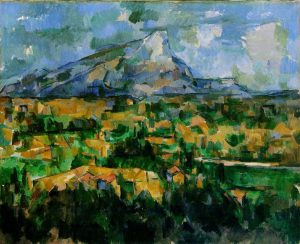Paul Cézanne, Mont Sainte-Victoire
Paul Cézanne’s desire to “make of Impressionism something solid and enduring” led him to formulate a new approach to the art of painting whether his subject was landscape, still life, or the human figure. Cézanne’s distinctive way of studying nature is evident in Mont Sainte-Victoire, one of many views that he painted of this mountain near his home in Aix-en-Provence. His aim was not truth in appearance, especially not photographic truth, nor was it the “truth” of Impressionism. Rather, he sought a lasting structure behind the formless and fleeting visual information that the eyes absorb.

Cézanne set out to explore the properties of line, plane, and color, and their interrelationships. He studied the capacity of lines and planes to create the sensation of depth, the intrinsic qualities of color, and the power of colors to modify the direction and depth of lines and planes. To create the illusion of three-dimensional form and space, Cézanne focused on carefully selecting colors. He understood that the visual properties – hue, saturation, and value – of different colors vary. Cool colors tend to recede, whereas warm ones advance. By applying to the canvas small patches of juxtaposed colors, some advancing and some receding, Cézanne created volume and depth in his works.
Cézanne replaced the transitory visual effects of changing atmospheric conditions, effects that preoccupied Monet, with a more concentrated, lengthier analysis of the colors in large lighted spaces. The main space stretches out behind and beyond the canvas plane and includes numerous small elements, such as roads, fields, houses, and the viaduct at the far right, each seen from a slightly different viewpoint. Above this shifting, receding perspective – so different from traditional Renaissance perspective with the viewer standing in a fixed position and with a single vanishing point – the largest mass of all, the mountain, seems simultaneously to be both near and far away, an effect achieved by equally stressing background and foreground contours. [1]
- Fred S. Kleiner, Gardner’s Art Through the Ages: The Western Perspective, vol. 2, 15th ed., (Boston: Cengage Learning, 2017), 740. ↵

